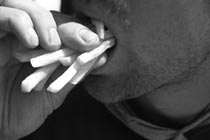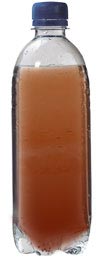| (insert your NIE or newspaper logo here) |
Weekly Online LessonOnline Lesson ArchiveGrade Level: 7-12
|
Unhealthy Choices Deliver Hefty Results
 America's growth has captured news headlines lately — but the growth isn't about the economy, population numbers, or the entertainment industry. Instead, the focus is on sprawling waistlines.
America's growth has captured news headlines lately — but the growth isn't about the economy, population numbers, or the entertainment industry. Instead, the focus is on sprawling waistlines.
On January 5, 2004, a study published in the monthly issue of Pediatrics concluded that the nation is in the midst of an obesity epidemic.
More recently, the World Health Organization suggested that fast-food chain advertising targeted at kids and teens be regulated by nations, including the U.S. On Friday, January 16, President George W. Bush challenged that recommendation, saying that WHO's suggestions should focus more on an individual's responsibility to balance diet and exercise, rather than singling out one type of food.
Obesity can be defined as an excessive accumulation of body fat, which results in individuals being at least 20 percent heavier than their ideal body weight. "Overweight" is defined as any weight in excess of the ideal range.
Childhood obesity in the U.S. has doubled over the past decade, and compared to 14 other nations, American youth are generally the heaviest in the world. Nearly one in six teens is obese, and about one in three is "modestly overweight."
The causes? Experts agree that eating too much fat and sugar, along with too much sitting and not enough exercise, are the primary culprits.
Obesity is a huge problem, since it usually affects more than your appearance and clothing size. What were once illnesses largely suffered by adults are now showing up more and more in America's youth: severe breathing trouble, heart and gallbladder diseases, diabetes, and some forms of cancer.
To solve this problem, people should avoid crash dieting or surgery and focus more on living a balanced lifestyle. To understand how to do that, this week's lesson will explain obesity's causes and concerns, and show you how to watch what you eat and get your feet moving.
What Is Obesity?
 Get started at the TeensHealth site, sponsored by The Nemours Foundation. Under Food & Fitness, jump to the Obesity section, which provides a basic overview of this health condition.
Get started at the TeensHealth site, sponsored by The Nemours Foundation. Under Food & Fitness, jump to the Obesity section, which provides a basic overview of this health condition.
As you read through the pages, you can click on any of the underlined words to explore the related topics. Use your browser's Back button to return to the original page.
First, read about what obesity is, then turn to the next page and discover What Causes Obesity? What are some of the reasons people gain weight? What causes are hereditary and which can people control?
On the Next Page, you'll find out who is at-risk for obesity and how it can affect one's health. Is obesity preventable? In what ways can obesity throw your mind and body off balance?
Lastly, discover How You Can Avoid Becoming Overweight or Obese, and, if you are obese, what you can do about it.
Energy In = Energy Out
 Now, let's get into some of the science of calories to understand what role they play in your daily food and exercise equation.
Now, let's get into some of the science of calories to understand what role they play in your daily food and exercise equation.
Begin by learning How Calories Work, at the HowStuffWorks website. After reading the Introduction, find out What is a Calorie? and What Calories Do.
So, what is the scientific definition of a calorie? In what ways do we use the term in daily life? Why exactly do we need to consume calories? How many calories would you consume, if you ate three grams of fat compared to three grams of protein?
Try testing the math example on a labeled food item of your own. Which category contributes the most calories?
Next, find out about Your Caloric Needs, and Calories, Fat and Exercise. What are the three main factors that determine your daily calorie intake? What happens when the energy in exceeds the energy out?
Okay, so you've seen how to keep the energy equation balanced, but what do you do if you're overweight?
To answer that question, check out How Dieting Works. Do you recognize any of the famous diet names, from ads or because people you know have tried them?
 After reading the Introduction, learn more about Your Body's Efficiency. How many "miles per gallon" does a human body average?
After reading the Introduction, learn more about Your Body's Efficiency. How many "miles per gallon" does a human body average?
Next, find out about Taking Calories In, The Idea Behind Dieting, and Why Diets Tend Not To Work.
How exactly do the pounds add up, and how can they get burned off? Why is it important to change your "normal eating pattern" rather than focus on a short-term "diet"?
The first step in transforming your unhealthy routines is to work on Building a Sustainable Diet, Fitting in Exercise, and break some Weight Loss Myths.
Start thinking about how you could adjust your lifestyle to get healthier. Keep an honest diary of your food intake and exercise level for a day or two.
Where do you think you might be able to give up calories? For example, if you don't want to swear off fast-food completely, would you prefer to visit the drive-thru less frequently or cut down on calories elsewhere? What planned physical activities could you add to your schedule? How often could you take the stairs instead of the elevator or escalator?
Your Take-Control Toolbox
 The National Institutes of Health offer a great site to help you Aim For A Healthy Weight.
The National Institutes of Health offer a great site to help you Aim For A Healthy Weight.
Under Information for Patients and the Public, read the Introduction and browse the Key Recommendations.
Then move on to Part 1: Assessing Your Risk and the BMI Calculator. Is your BMI outside the normal weight range?
Next, browse Part 2: Controlling Your Weight, going first to Portion Distortion to take the quiz. Were you surprised by any of the facts?
Now, go to the Menu Planner and choose a day's meals that mirror your current routine. Either print out the results or open a new browser window. Think about where you're willing to make different choices, like eating healthier snacks or cutting down on serving sizes. Then, create a new daily menu with fewer total calories, and compare the results with your first menu. Do you feel those changes to cut your intake are doable?
If you have time, browse the rest of the Part 2: Controlling Your Weight section, including the Guide to Physical Activity, Guide to Behavior Change, Shopping: What to Look For, and the Tip Sheets. You can also print out and use the handy Daily Food and Activity Diary.
Newspaper Activities
In a current issue of Targetnewspaper, find articles about health or policy issues related to obesity or unhealthy lifestyles. What is the government's tactic for shaping up American citizens? What tactics are fast-food chains taking to attract customers who are more health-conscious? Does the article tell any personal stories of people living with obesity? If so, what issues or challenges do they face in getting healthier? Also, browse the newspaper to find references of the following: weight loss (like diets or support groups), food consumption (like restaurant ads or coupons), low-level physical activities (like video games), and high-level physical activities (like swimming or hiking). How do the number of weight loss references compare to those of food consumption? What about low-level vs. high-level exercise?
© Copyright 2004
Learners Online, Inc.
